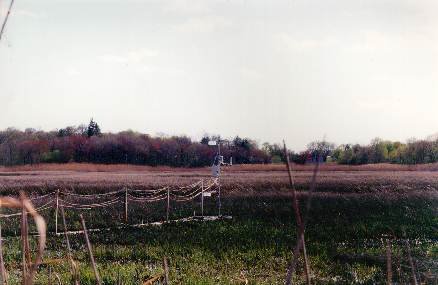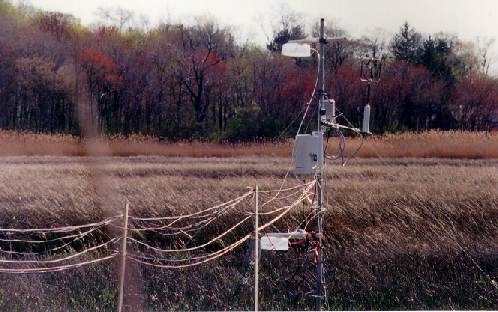
| Home | |
| About The Museum | |
| Donate! | |
| The Collection | |
| Membership | |
| Guest Operators | |
| Volunteer | |
| Site Map | |
| Members Only |
The trackage of the Shore Line Trolley Museum winds through the tidal marshlands of the Long Island Sound, a pristine, preserved area where herons, egrets and sandpipers can be found in abundance. In addition to preserving the demonstrable use of emission-free electric rail transit (an option that many cities are once again turning to, under the new monicer of Light Rail), the museum been recognized for more direct and tangible acts to preserve the environment.
In 1991, the museum partnered with the Branford Land Trust to achieve environmentally protected status for the wetlands surrounding the museum's property. The museum's members gave their financial support towards purchasing and ceding to the Branford Land Trust a "buffer zone" of adjacent property. These acts help ensure protection for the wetlands and the creatures that live within against potential future encroachment of commercial development.
Other recent efforts of the museum include nature walks through the majestic Beacon Hill, overlooking the property. In 1996, museum members assisted in removing long-abandoned vehicles from an area difficult to reach via conventional means, by using the museum's rail crane.
Given the Shore Line Trolley Museum's tradition of environmental concern, a request by Yale University to utilize part of our property for environmental research was met with welcome and enthusiasm. In June of 1997, Professor Lee of Yale's School of Forestry and Environmental Studies set up a small monitoring station in the marsh, about 100 feet south of our tracks, near the "picnic grove" trolley car stop.
Professor Lee's research involves the toxin mercury. As one thinks of mercury, a liquid in a thermometer bulb, one might not realize that even at room temperature, a liquid pool of mercury is "boiling away", releasing trace amounts of mercury vapor into the atmosphere. While the effect is small, the net result from a large accumulation of mercury can have implications both for wildlife and human health, as once mercury is introduced into the ecosystem, it remains in the food chain, being passed from plant to animal, from prey to predator.
The marsh, explains Professor Lee, is a dynamic entity that can both absorb mercury vapor and release it, much as plants can either consume or produce carbon dioxide in their photosynthesis cycle. While groundwater mercury contamination from industrial runoff and dumping is one source of accumulated mercury, a significant amount of contamination is believed to enter from the air. These airborne mercury vapors are produced primarily in the industrial combustion of coal. Automotive emissions are also a significant contributor, with major roadways such as I-95 creating a plume of vapor that often settles miles away.
Professor Lee's apparatus include basic meteorological gauges to
record temperature, humidity, barometric pressure, etc., as well as
sensitive instruments that measure the concentration of airborne mercury.
His first trials lasted for approximately one month, being run in
June and July of 1997. During that time, Professor Lee and his graduate
students made frequent trips to the monitoring station. As its location
precluded the use of automobile, these researchers took the trolley,
much as any average Joe might have while the line was in passenger service
from 1900 through 1947 (notwithstanding the fact that "Joe" would not likely
be trekking out to work with delicate electronic instruments!)
 |
| The apparatus, installed in the marsh |
 |
| A close-up view |
The initial results were extremely promising and shed light on the factors that affect the mercury vapor cycle, according to Lee and other researchers who inspected the site during that month. One of the "wish list" items presented to the museum for future work was to have electrical power available at the site. Of course, 600 Volt DC trolley power was in ample supply, but conventional 120V, 60Hz power was what was needed. Towards this end, Yale University generously donated to the museum the electrical supplies necessary to bring power down the line to this location. This donation has an ancillary benefit to the museum of improving the power distribution for the railway signal system, and providing a power source for a radio repeater station.
The electrical supplies arrived in November, and museum volunteers have been hard at work, contributing their labor towards installing the gear. The project, scheduled for completion in early March, came in ahead of schedule in mid-January. Professor Lee, who has also been receiving some "on-the-job training", has been lending a hand as well, and looks forward to a stable source of power. The 1997 trials required the use of a portable generator which requires frequent refueling and attention and doesn't like to be run in cold weather. The new power lines should allow several months of 24/7 monitoring, as well as eliminating the diesel engine - a minor but annoying contaminant source. We at the Shore Line Trolley Museum look forward to the resumption of the project in March as well as to future collaboration with the University.
If you'd like more information, please see http://pantheon.yale.edu/~xhlee